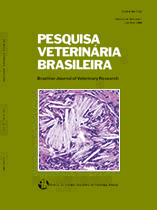 |
|
|
|
Year 2016 - Volume 36, Number 5
|

|
Identification of lamb flocks susceptible and resistant against Brachiaria poisoning, 36(5):383-388
|
ABSTACT.- Pupin R.C., Melo G.K.A., Heckler R.F., Faccin T.C., Ítavo C.C.B.F., Fernandes C.E, Gomes D.C. & Lemos R.A.A. 2016. Identification of lamb flocks susceptible and resistant against Brachiaria poisoning. Pesquisa Veterinária Brasileira 36(5):383-388. Laboratório de Anatomia Patológica, Faculdade de Medicina Veterinária e Zootecnia, Universidade Federal de Mato Grosso do Sul, Av. Senador Filinto Müller 2443, Campo Grande, MS 79074-460, Brazil. E-mail: ricardo.lemos@ufms.br
This study was designed to assess the influence of genetic resistance against brachiaria poisoning in sheep. Two groups of sheep, one identified as susceptible (formed by two ewes and one ram) and the other as resistant against brachiaria poisoning (formed by three ewes and one ram) were selected. Sheep considered susceptible were those that presented clinical signs of brachiaria poisoning at any time of their life; resistant sheep were those that even raised on Brachiaria spp. pastures, did not developed any sign of the poisoning during their life. The offspring of the two flocks (15 lambs from the sensitive flock and 9 lambs from the resistant flock) were placed into brachiaria pasture (initially Brachiaria decumbens and B. brizantha,and only B. decumbens after weaning) and followed up during two years (2013-2014). The determination of protodioscin levels in B. decumbens pasture was performed only in 2014 and revealed significant amounts of the toxic principle. Eleven lambs of the susceptible group were affected to some degree of brachiaria poisoning and six died; no lamb of the resistant group was affected. Clinical signs consisted of varying degrees of subcutaneous edema of the face and, erythema and loss of hair of the ears, crusts on the skin of ears, around the eyes and on planum nasale, scar deformation of the ears, and bilateral ocular discharge; affected lambs also sought for shadowy shelters and they were poor doers. Several sheep recovered from the condition and then relapsed. Necropsy findings in six lambs included pale mucous membranes, emaciation, dermatitis, scar deformation of the ears, large yellow livers with marked lobular pattern, and moderate infestation by Haemonchus contortus. Histologically the liver lesions were similar in all necropsied lambs but with varying degrees of severity; they were consistent with brachiaria poisoning and included architectural disruption of hepatocellular trabecula, clusters of foamy macrophages occasionally forming multinucleated giant cells, swollen and vacuolated hepatocytes, crystals or negative images of crystals in the biliary system, bilestasis, bile duct proliferation and lymphoplasmacytic infiltrate in portal triads. The skin lesions were those of photodermatitis and included epidermal necrosis, hyperkeratosis and dermal neutrophilic infiltrate. The results of this study allow to conclude that there is a genetic related resistance to brachiaria poisoning in sheep since the progeny of resistant sheep did not manifest the poisoning. The use of resistant flocks in brachiaria pastures is suggested as a valuable option for the prevention of brachiaria poisoning in sheep. |
| |
|
|
| |
|
 |